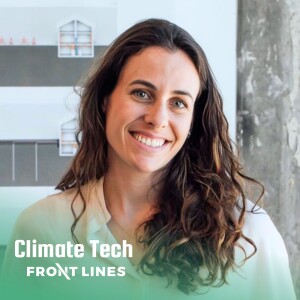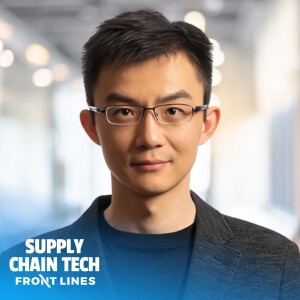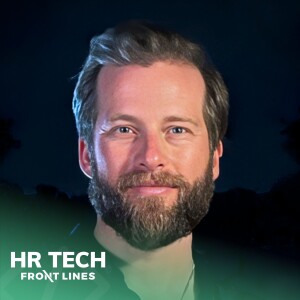Category Visionaries
Welcome to Category Visionaries — the show dedicated to uncovering the go-to-market journeys behind the world’s most exciting B2B tech startups. In each episode, we sit down with a visionary founder who’s not just building a company, but creating or redefining a category. We’ll explore how they identified their market opportunity, crafted their early GTM strategy, scaled traction, and navigated the challenges of building something truly new. If you’re a builder, marketer, or founder, this show is your backstage pass to the GTM blueprints powering category-defining companies. Brought to you by: www.FrontLines.io/FounderLedGrowth — Founder-led Growth as a Service. Launch your own podcast that drives thought leadership, demand, and most importantly, revenue. Don’t Miss: New Podcast Series — How I Hire Senior GTM leaders share the tactical hiring frameworks they use to build winning revenue teams. Hosted by Andy Mowat, who scaled 4 unicorns from $10M to $100M+ ARR and launched Whispered to help executives find their next role. Subscribe here: https://open.spotify.com/show/53yCHlPfLSMFimtv0riPyM
Episodes

Wednesday May 14, 2025
Wednesday May 14, 2025
Safire is pioneering advanced electrification solutions for defense applications, transforming how military operations are powered in austere environments. With $11 Million in funding and over $7 million in government contracts secured just this year, Safire is developing revolutionary technology to make batteries safer and more efficient for defense applications. In this episode of Category Visionaries, I spoke with John Lee, CEO and Founder of Safire, to learn about the company's journey from a core nanoparticle technology to a full suite of defense electrification products that are changing how soldiers operate in the field.
Topics Discussed:
Safire's revolutionary silicon nanoparticle technology that transforms lithium-ion batteries into "non-Newtonian fluids" that solidify upon impact
The company's evolution from core R&D to developing multiple defense products, including tactical electric dirt bikes, battery-infused body armor, and deployable microgrids
The process of securing government contracts and navigating defense appropriations
The importance of building relationships with end users in the military and understanding their needs
John's background as a Navy contracting officer and former head of government contracts at Palantir
Safire's approach to brand development as part of their path to becoming a unicorn
GTM Lessons For B2B Founders:
Put mission first to attract talent and customers: John's commitment to protecting lives became his driving force after his experience procuring counter-IED jammers that saved soldiers' lives. He explains, "I couldn't really do anything besides, whatever I do, I want to help protect and save lives." This clear mission has helped him attract talent, customers, and investors who share this vision, demonstrating how a compelling purpose can accelerate GTM efforts.
Listen to customer needs before defining your product roadmap: Rather than forcing a single-product strategy, Safire let customer requirements guide their development. As John noted, "We really focused on customer first. And if the customer said, I want you to be just one product company... that may have been okay. But that's not what the customer was asking for." By building solutions to address real military needs, Safire has secured multiple contracts across different applications.
Use government R&D contracts as a runway to production: Safire strategically leveraged Small Business Innovation Research (SBIR) contracts to fund their early development while creating a path to larger production contracts. John advises, "It's really important to understand... all the effort it takes to go from the R&D contract into production into program of record and [to] prepare for it." He warns against the "if I build it they'll come" mentality that leads many startups to fail.
Invest in lobbying early for long-term ROI: The company prioritized hiring lobbyists immediately after raising their seed round. John revealed, "The $4.5 million contract that we just got awarded last month came from our lobbying efforts... from two and a half years ago. And that was the very first third-party payment I was making as soon as we raised our seed round." This demonstrates how early investment in government relations can deliver substantial returns for defense tech companies.
Brand sophistication matters in defense tech: Breaking with industry norms, Safire invested significantly in professional branding before their Series A. John explains this decision: "Every unicorn status company had a great brand before they became a unicorn status company... When we're walking through four-star generals and three-star generals into our offices, into our skiffs... we want to be trusted and we also want to be seen as a sophisticated, responsible contractor." This approach has helped them stand out in an industry where branding is often neglected.
//
Sponsors:
Front Lines — We help B2B tech companies launch, manage, and grow podcasts that drive demand, awareness, and thought leadership.
www.FrontLines.io
The Global Talent Co. — We help tech startups find, vet, hire, pay, and retain amazing marketing talent that costs 50-70% less than the US & Europe.
www.GlobalTalent.co
//
Don't Miss: New Podcast Series — How I Hire
Senior GTM leaders share the tactical hiring frameworks they use to build winning revenue teams. Hosted by Andy Mowat, who scaled 4 unicorns from $10M to $100M+ ARR and launched Whispered to help executives find their next role.
Subscribe here: https://open.spotify.com/show/53yCHlPfLSMFimtv0riPyM

Wednesday May 14, 2025
Wednesday May 14, 2025
Cloverleaf AI is revolutionizing how companies access and leverage public government meeting data, turning hours of meandering discussions into actionable sales intelligence. With $3.5 million in funding, the govtech startup helps enterprises identify early-stage opportunities in state and local government contracts by applying AI to analyze thousands of public meetings. In this episode of Category Visionaries, I sat down with Jeremy Becker, Co-Founder and Chief Revenue Officer of Cloverleaf AI, to explore how his childhood experiences attending local government meetings with his father inspired a solution that's changing how businesses engage with government procurement.
Topics Discussed:
How Cloverleaf AI uses machine learning to extract valuable insights from public government meeting recordings
The challenges of finding and tracking government opportunities without AI assistance
Why state, local, and education (SLED) markets represent their strongest differentiator
The impact of federal deregulation on state-level government contracting opportunities
Cloverleaf's successful pursuit of enterprise clients, including a recent deal with one of the world's five largest companies
GTM Lessons for B2B Founders:
Focus relentlessly on your beachhead market: Jeremy identified choosing government contracting as their sole focus as their most critical decision. "We tried to boil the ocean...but you just limit yourself so much in what you can learn about your process and how much more repeatable you can get with things if you get smaller." Initially targeting multiple verticals (government affairs, government contracting, political strategy), Cloverleaf found its sales velocity was 5x higher in government contracting than other segments.
Translate technical capabilities into customer-centric language: Cloverleaf struggled initially with messaging until they shifted from generic promises like "we'll drive revenue" to more relationship-focused language that resonated with their audience: "Government sales are about building relationships and being proactive. Let us help you get into the room a little bit earlier." This translation of technical capabilities to customer-centric outcomes was crucial for market penetration.
Leverage unique data assets in your marketing: Rather than generic content marketing, Cloverleaf uses its proprietary government meeting data to deliver unique insights and analysis that potential customers can't get elsewhere. Their strategy of offering free licenses to journalists and educational institutions creates organic distribution channels while building credibility through third-party validation.
Conduct thorough procurement discovery upfront: After a 16-month sales cycle with a major enterprise client, Jeremy emphasized the importance of procurement discovery: "Always better discovery, specifically better procurement discovery from the start would have been a pretty big game changer." Understanding organizational structures, decision-makers, and internal processes early prevents "false summits" where you think the deal is closing only to discover new layers of approval.
Validate market selection with sales velocity metrics: When deciding which market to focus on, Cloverleaf analyzed their existing client base using sales velocity (combining cycle time and deal size) rather than looking at individual metrics in isolation. This comprehensive view revealed that government contracting opportunities closed 5x faster than government affairs deals, providing clear direction for their go-to-market strategy.
//
Sponsors:
Front Lines — We help B2B tech companies launch, manage, and grow podcasts that drive demand, awareness, and thought leadership.
www.FrontLines.io
The Global Talent Co. — We help tech startups find, vet, hire, pay, and retain amazing marketing talent that costs 50-70% less than the US & Europe.
www.GlobalTalent.co

Tuesday May 13, 2025
Tuesday May 13, 2025
Dandelion Energy is revolutionizing residential heating and cooling through geothermal technology, transforming what was once a luxury product into a mainstream, accessible solution for homeowners across America. In this episode of Category Visionaries, I spoke with Kathy Hannun, Founder and CTO of Dandelion Energy, who spun the company out of Google X after recognizing geothermal's potential to disrupt the traditional home heating and cooling market. With $175 million in funding, Dandelion has evolved from direct-to-consumer retrofits to focusing on partnerships with home builders, dramatically reducing installation costs while maximizing scalability.
Topics Discussed:
Dandelion's origin as a spinout from Google X's moonshot factory
The transition from a direct-to-consumer retrofit model to partnering with homebuilders
How geothermal technology works and why it provides superior heating and cooling
Innovations that made geothermal systems accessible to average homeowners
The challenges of managing supply-demand dynamics in a construction-based business
Financing strategies that made zero-money-down installations possible
The development of Dandelion's brand identity and naming process
The impact of government incentives on adoption rates (up to $30,000 in some markets)
Future vision to make geothermal a standard option considered by major homebuilders
GTM Lessons for B2B Founders:
Pivot When Your Business Model Shows Structural Flaws: Kathy recognized fundamental challenges in their direct-to-consumer retrofit approach that threatened long-term viability. Rather than forcing a flawed model, they pivoted to a B2B strategy targeting homebuilders, which cut installation costs by more than 50% while enabling greater scalability. Kathy explained, "The business model we had in the past, it was flawed... I was pretty anxious about what the future looked like in that business model. Whereas in this home builder business, it just really addresses many of the weaknesses of our old business model."
Borrow Go-To-Market Strategies from Adjacent Industries: Dandelion's initial success came from applying solar industry financing models to geothermal, making expensive systems affordable through zero-money-down financing. Kathy shared, "We really just stood on the shoulders of the solar industry... it allowed us to offer a zero money down product which was also half of our customers used." By adapting proven strategies from adjacent sectors, B2B founders can accelerate adoption of new technologies.
Adapt Marketing Strategies to Current Realities: Kathy initially received advice from solar industry veterans suggesting community events and farmer's markets for customer acquisition. While applying this advice, she quickly discovered digital ads were far more cost-effective. As she noted, "In retrospect, I realized the solar industry kind of came of age before digital ads were such a big deal. And so all the advice I had gotten was a little bit out of date." B2B founders should consider the context and timing when applying historical industry advice.
Address Technology Limitations That Constrain Market Size: When Dandelion discovered that standard water well drilling rigs were too large for many residential properties, they developed smaller specialized equipment that instantly doubled their addressable market. Kathy recalled, "For half the homeowners that said yes to us, yes, I want to buy geothermal from you, we had to say actually nevermind, because your house cannot accommodate a giant water well rig on the yard." Identifying and solving technical barriers that limit adoption can dramatically expand market reach.
Leverage Mission-Driven Status for Marketing Advantages: Dandelion's environmental mission generated media coverage and public interest that traditional HVAC companies couldn't access. Kathy observed, "Starting a company that is mission driven like Dandelion has been a big advantage because we get a fair amount of press coverage and people are inherently somewhat interested in the thing that we're doing." B2B founders working on solutions with broader positive impacts should leverage this narrative advantage in their marketing strategy.
//
Sponsors:
Front Lines — We help B2B tech companies launch, manage, and grow podcasts that drive demand, awareness, and thought leadership.
www.FrontLines.io
The Global Talent Co. — We help tech startups find, vet, hire, pay, and retain amazing marketing talent that costs 50-70% less than the US & Europe.
www.GlobalTalent.co

Tuesday May 13, 2025
Tuesday May 13, 2025
Intenseye is revolutionizing industrial safety by connecting to existing camera systems in manufacturing facilities and using AI to detect unsafe conditions in real-time. Having raised $93 million to date, the company has developed a platform that runs over 120 AI models analyzing 50+ safety use cases at manufacturing sites globally. In this episode of Category Visionaries, we spoke with Sercan Esen, CEO and Co-Founder of Intenseye, about his journey from software engineer to category-creating founder, and how his company is addressing the staggering problem of workplace fatalities – 2.4 million people losing their lives annually in industrial accidents.
Topics Discussed:
Intenseye's origin story and mission to save lives in manufacturing
How the platform transforms existing cameras into "24/7 safety supervisors"
The challenge of creating a new category in industrial safety
Building an account-based marketing engine from scratch
The evolution from a proof-of-concept to an enterprise-ready solution
Scaling from single facility deployments to managing 100+ site implementations
How real-time detection differs fundamentally from traditional EHS platforms
GTM Lessons For B2B Founders:
Learn directly from your customers on category creation: "We came up with those category names. We named those use cases and main categories and we expanded them under like 50 new use cases too... So I would say the number one thing that we do really well is relying on our customers, our users on the front lines, and how they use our platform and operationalize and what they call it." Sercan emphasized the importance of letting your customers help shape how you define and communicate about your new category, rather than imposing terminology on them.
Immerse yourself in your customer's world: Sercan personally visited over 50 manufacturing facilities in the first two years and even worked production lines to understand the environment. "I was making ice creams for a week, cars for another week. And I was working right next to frontline teams to learn more." This deep immersion helped Intenseye build a solution that truly addressed the realities of their customers' environments rather than creating a theoretical solution from a distance.
Iterate your go-to-market motion with the help of early customers: The Intenseye team originally envisioned a self-serve, product-led growth model but quickly realized enterprise sales was the right approach. Sercan recalls: "I remember my first call with the procurement leader from a largest customer and he was challenging me and I said, 'Look, this is the first time I'm doing this. Can you tell me how you guys want to buy this? You tell me and I will just figure this out.' And he gave me amazing insights." This willingness to learn from customers shaped their land-and-expand strategy and pricing model.
Deeply understand stakeholder concerns to drive adoption: When implementing computer vision in industrial settings, Sercan's team anticipated potential resistance and built solutions proactively: "We are always aggressively cautious about the implementation of computer vision technology because immediate reaction might be 'Hey, this is Big Brother...' But these are all wrong. We spend a lot of time with unions, frontline teams, building anonymization around blurring the entire body at the camera level, thumbnail level, and everything... to earn their trust, earn their hearts and minds."
Create targeted marketing content that demonstrates your exact solution: Rather than generic marketing, Intenseye built a video engine that could analyze customer video footage using their AI, showing precisely how their system would work in a prospect's actual environment. "I posted on LinkedIn, promoted in the region where I know that account could see our video... I remember couple hours later it was a meeting booked from the VP of Healthcare Safety with a note: 'Hey, I'm really interested about this solution.'" This approach of showing exactly how you solve the specific problem has become the foundation of their marketing strategy.
//
Sponsors:
Front Lines — We help B2B tech companies launch, manage, and grow podcasts that drive demand, awareness, and thought leadership.
www.FrontLines.io
The Global Talent Co. — We help tech startups find, vet, hire, pay, and retain amazing marketing talent that costs 50-70% less than the US & Europe.
www.GlobalTalent.co

Friday May 09, 2025
Friday May 09, 2025
Katmai is reinventing remote work through its innovative virtual office platform that creates spontaneous, natural interaction in a digital environment. With over $30 million in funding, Katmai has developed proprietary 3D audio-video technology that allows teams to work together in a virtual space that mimics the benefits of physical offices while maintaining the flexibility of remote work. In this episode of Category Visionaries, we sat down with Erik Braund, CEO and Founder of Katmai, to learn about his journey from audio-video production to building a deep tech startup that's challenging conventional remote work tools like Zoom and Microsoft Teams.
Topics Discussed:
Katmai's origin as an accidental pandemic pivot from Erik's audio-video production business
The acquisition of early prototype technology and building a specialized team of engineers
The technical challenges of creating a browser-based 3D environment with live audio-video
Katmai's approach to product development through careful beta testing and customer feedback
The transition from deep tech R&D to commercial product and go-to-market strategy
The tension between maintaining stealth mode while gathering essential user feedback
Katmai's expansion from enterprise customers to consumer-facing experiences
The philosophical approach to remote work that focuses on spontaneous interaction
GTM Lessons For B2B Founders:
Prioritize real-world functionality over pitch decks: Erik emphasized that for complex, visual products like Katmai, traditional pitch materials didn't work. "We didn't even have a deck for series A because they don't work. The deck doesn't work. You've got to just see it or see a video of it." B2B founders with experiential products should prioritize creating functional demos over traditional marketing materials.
Build around natural behavior patterns: Katmai succeeded by mapping digital interactions to natural in-person behaviors. "We map everything one-to-one of what would it be like to sit next to each other at a table and show each other laptops and have a conversation and then look over the shoulder." Founders should design products that feel intuitive by mimicking familiar real-world interactions rather than creating entirely new behavioral patterns.
Balance technological innovation with methodical rollout: As a deep tech investment, Katmai spent years on R&D before broader release. "Had I known how to frame it on day one, I would have pitched it as a deep tech investment... we're going to be heads down for like two more years, just hashing this out, making it work." B2B founders working on fundamental innovations should set appropriate timelines and expectations for both investors and customers.
Transform scheduled meetings into spontaneous conversations: Katmai's core value proposition addresses meeting fatigue. Erik shared customer feedback: "Katmai turns next week's 30 minute meeting into today's 5 minute conversation." B2B founders should identify where their product can eliminate friction in workflows rather than simply digitizing existing processes.
Implement gradual adoption strategies: Recognizing behavior change is difficult, Katmai recommends an "office hours" approach to adoption. "Take your stand up that you were going to do with your remote team and do it in Katmai. Maybe that's once a week, maybe it's every day... then don't leave when the meeting's over." B2B founders should create clear, incremental adoption pathways that don't require customers to immediately abandon existing tools.
//
Sponsors:
Front Lines — We help B2B tech companies launch, manage, and grow podcasts that drive demand, awareness, and thought leadership.
www.FrontLines.io
The Global Talent Co. — We help tech startups find, vet, hire, pay, and retain amazing marketing talent that costs 50-70% less than the US & Europe.
www.GlobalTalent.co

Monday May 05, 2025
Monday May 05, 2025
Tilled has pioneered "PayFac as a Service," creating a new category in the payments space that allows vertical software companies to embed payments within their platforms without becoming registered payment facilitators themselves. With over $40 million in funding, Tilled offers an alternative to industry giants like Stripe, providing better economics while maintaining high-quality developer tools. In this episode of Category Visionaries, I spoke with Caleb Avery, Founder and CEO of Tilled, about his journey from solo founder to category creator, the challenges of competing with established players like Stripe, and how he's built a successful business by identifying and serving an underserved segment of the market.
Topics Discussed:
Tilled's origin story and Caleb's two-year journey as a solo founder before finding product-market fit
The process of creating and defining the "PayFac as a Service" category
How Tilled positions itself against industry giants like Stripe
Effective content marketing and thought leadership strategies on LinkedIn
The power of speaking at industry conferences to build credibility
Leveraging a mixed strategy of inbound marketing, digital advertising, and channel partnerships
Tilled's vision to expand beyond payments into comprehensive embedded fintech solutions
GTM Lessons for B2B Founders:
Create your own category when existing ones don't fit: When Caleb realized that existing terms like "PayFac in a box" didn't accurately describe Tilled's offering, he invented "PayFac as a Service." This new category clearly communicated their value proposition and differentiated them from competitors. He explains, "The concept behind PayFac as a Service was really resonating with these vertical software companies that were saying, 'I don't want to go be a registered PayFac, I want all of the benefits as though I'm becoming a registered payment facilitator with 5% of the effort.'"
Educate the market on your category through content: Tilled invested heavily in education through LinkedIn posts, blogs, ebooks, and speaking engagements to establish their category. Caleb notes, "Over a period of three or four months, we started introducing this concept of PayFac as a Service...by the time we actually launched the fundraising process, some of the early investors that I talked to were like, 'Oh, yeah, we've heard of that category.'"
Leverage fellow founders for early validation: Even without a product, Caleb reached out to other founders to validate his ideas. "Other founders are very willing to help founders, especially in the early stages where I had nothing to sell them...I was shocked by the response rates that I was getting." This approach helped validate assumptions about pricing, product features, and contractual terms before launch.
Balance personal and professional content for thought leadership: Caleb's LinkedIn strategy combined educational content about payments with personal stories about entrepreneurship and family life. "I think by allowing people to understand who I was as a person, it made me more approachable for some of the companies that were coming to us and saying, 'Hey, we're not ready to make a switch, but we are curious.'"
Apply to speak at industry conferences: Caleb was surprised by how many speaking opportunities were available simply by applying. "It just shocks me how few founders that I know are willing to go apply for those speakerships, but it's really an incredibly easy thing for them to go do." These speaking engagements provided valuable opportunities to reach ideal customers and establish credibility.
Run targeted "conquest" campaigns against market leaders: Tilled runs specific digital advertising campaigns targeting pain points with competitors, using long-tail keywords like "Why is Stripe customer service so bad?" This strategy drives quality leads from customers already experiencing problems with the dominant player in the market.
Embrace channel partnerships in B2B SaaS: Unlike many competitors, Tilled welcomes referrals from ISOs, agents, and payment consultants. "We're one of the few folks in our space, which is still bizarre to me, that embraces a channel strategy...it's been an incredibly lucrative strategy...it's still 30 plus percent of the deal flow for Tilled."
//
Sponsors:
Front Lines — We help B2B tech companies launch, manage, and grow podcasts that drive demand, awareness, and thought leadership.
www.FrontLines.io
The Global Talent Co. — We help tech startups find, vet, hire, pay, and retain amazing marketing talent that costs 50-70% less than the US & Europe.
www.GlobalTalent.co

Wednesday Apr 30, 2025
Wednesday Apr 30, 2025
Bot Auto is redefining the autonomous driving industry with a pragmatic, economics-first approach. With over $45 million in funding, the company is positioning itself as a trucking company that leverages autonomous technology, rather than a technology vendor selling autonomous systems. In a recent episode of Category Visionaries, I spoke with Dr. Xiaodi Hou, CEO of Bot Auto, who shared his decade of experience in autonomous vehicles and his vision for creating a profitable business that delivers transportation capacity more efficiently than human drivers.
Topics Discussed:
Bot Auto's evolution from deep learning applications to autonomous trucking
The strategic advantages of highway trucking over urban autonomous driving
Why cost per mile (CPM) provides a better North Star metric than miles per intervention
Bot Auto's business model as a trucking company first, technology company second
The industry-wide challenge of rebuilding credibility after years of overpromising
Projected timeline: 30 trucks by 2026, breakeven with 100 trucks by 2027
Lessons learned from previous ventures in autonomous driving
The future impact of autonomous trucking on transportation infrastructure
GTM Lessons For B2B Founders:
Position as a service provider, not a technology vendor: Bot Auto deliberately positions itself as a trucking company that happens to use autonomous technology, rather than an autonomous technology vendor. "Transportation itself is a service," Xiaodi explained. "Consider us as a trucking company. We are a trucking company, but in near future we will remove the human driver and then we can operate more efficiently than a traditional trucking company." B2B founders should consider whether selling a service that incorporates their technology might be more viable than selling the technology itself, particularly when customers lack the capabilities to implement complex technologies.
Design for seamless ecosystem integration: Rather than requiring new infrastructure or capabilities from customers, Bot Auto designed their offering to plug directly into the existing transportation ecosystem. "The ecosystem for transportation, for trucking is already there. And if we can be a kind of a painless, transparent replacement like equivalent to a human driven truck and supply the capacity to the ecosystem, then the ecosystem is already there. We don't even need to rebuild the ecosystem," Xiaodi noted. B2B founders should design their offerings to integrate with existing workflows and systems rather than requiring customers to build new capabilities around their technology.
Choose one definitive metric that drives all decisions: Bot Auto uses cost-per-mile (CPM) as their North Star metric for evaluating all business and technology decisions. "If your cost per mile is too high, no matter how experienced your partner is, or how ambitious you are, or how big your fleet is, if your cost per mile is negative, you will never make money," Xiaodi emphasized. This singular focus creates clarity across the organization. B2B founders should identify a similar "ultimate guideline" that directly ties to profitability and use it to evaluate every investment and initiative.
Focus on industry-wide credibility, not competition: Xiaodi strongly rejected the notion that autonomous trucking is a competitive space. "The autonomous driving industry is facing the biggest problem that is shared by everyone. That is the credibility of the whole industry. We collectively have promised too much and we have delivered too little," he explained. Instead of positioning against other startups, Bot Auto focuses on rebuilding trust in the entire category. B2B founders in emerging categories should consider how collective credibility impacts their success more than individual positioning against similar startups.
Create internal-external alignment: Bot Auto ensures perfect alignment between their internal goals and external messaging. "If your internal goal is to do something and your external presentation promises something very different, that always creates a clash of the company. Like basically you will be ending up with two companies under one stock symbol. That's very bad," Xiaodi warned. This alignment principle shapes how they communicate with investors and the market. B2B founders should ensure their internal metrics and priorities match what they promise externally, avoiding the trap of optimizing for different outcomes internally versus externally.
Use early revenue to discipline innovation: Unlike many deep tech startups with distant revenue horizons, Bot Auto designed their business model to generate revenue relatively quickly. This approach creates what Xiaodi calls a "self-regulation mechanism" that forces practical decisions: "Are you going to increase or decrease the CPM based on your new invention? Sometimes people do develop a flashy technology, but as soon as they realize that they're not going to reduce our cost per mile, then this is bad technology." B2B founders should design business models that generate early revenue to provide market validation and discipline their innovation efforts.
//
Sponsors:
Front Lines — We help B2B tech companies launch, manage, and grow podcasts that drive demand, awareness, and thought leadership.
www.FrontLines.io
The Global Talent Co. — We help tech startups find, vet, hire, pay, and retain amazing marketing talent that costs 50-70% less than the US & Europe.
www.GlobalTalent.co

Wednesday Apr 23, 2025
Wednesday Apr 23, 2025
Transcend is fundamentally changing how engineers design our world's essential infrastructure through their generative design platform. With $35 million in funding, including investment from industry giant Autodesk, Transcend is automating and optimizing the planning and conceptual design phases for infrastructure projects that typically cost tens to hundreds of millions of dollars. In this episode of Category Visionaries, we spoke with Adam Tank about how Transcend is creating an entirely new category while helping societies build more sustainable, efficient infrastructure from wastewater treatment plants to power systems.
Topics Discussed:
How Transcend's platform automates preliminary infrastructure design that traditionally requires months of manual work
The shift from a consumption-based pricing model to a flat-rate subscription that accelerated user adoption
Building a brand in a highly technical, conservative engineering market
Leveraging trade partnerships and owned media to educate potential customers
The importance of creating a category around "Generative Design for Critical Infrastructure"
How strategic investment from Autodesk removed concerns about startup viability
The challenge of selling to technical stakeholders who are resistant to change
GTM Lessons For B2B Founders:
Validate before building: Adam emphasizes trying to sell your solution before building it. "A lot of entrepreneurs fall into this mindset of 'if you build it, they will come'... Selling it, marketing it, is substantially harder in most cases than building the actual product itself."
Education-first marketing for technical buyers: When selling to engineers, plan for 10x more educational content than you might expect. "If I thought we needed to spend four hours a week doing it, we're spending 40 hours a week doing it across both sales and marketing teams." Create webinars, case studies, and detailed content that helps your technical audience understand and trust your solution.
Invest in owned media channels: Don't rely solely on platforms you don't control. Transcend created a newsletter reaching 16,000 engineers worldwide that isn't directly branded as Transcend but provides immense value and establishes authority. "If you rely on SEO only, or LinkedIn only... anything can change overnight."
Leverage trade partners for amplified reach: Instead of building everything yourself, tap into established networks in your industry. "We'll spend upwards of $5,000 to tap into someone else's network... and we'll get a thousand or more registrants and we've had half or more show up to the webinar, which is almost unheard of."
Challenge assumptions with data: Events are often assumed to be critical for relationship-based B2B sales, but Transcend found that "online events, webinars, our newsletters, our social media even, are far more consistent generator of high quality leads than events are for the spend."
Rethink pricing to encourage adoption: For complex products requiring significant user education, consumption-based pricing can unintentionally discourage exploration. "We made a big change about a year and a half or so into the company to move away from that consumption based pricing into just a flat rate model... We just want them in the tool, we just want them playing around with it."
Balance founder personal brand with company visibility: Adam maintains what he calls a "70-20-10" approach—70% water industry focus, 20% Transcend, and 10% personal. "People like to buy from people. They don't buy from companies. So the extent that a company can have a face that's out front that they can get to know and trust... is super important."
//
Sponsors:
Front Lines — We help B2B tech companies launch, manage, and grow podcasts that drive demand, awareness, and thought leadership.
www.FrontLines.io
The Global Talent Co. — We help tech startups find, vet, hire, pay, and retain amazing marketing talent that costs 50-70% less than the US & Europe.
www.GlobalTalent.co

Wednesday Apr 16, 2025
Wednesday Apr 16, 2025
In this episode of Category Visionaries, we spoke with Justin Leigh, CEO of Workflow Labs, an e-commerce management platform that's raised $3.5 million in funding. After running a successful Amazon agency for 14 years, Justin identified a critical opportunity: replacing human-driven processes with automation at scale. Workflow Labs is automating e-commerce management tasks that brands traditionally outsource to agencies or offshore teams, allowing for better economics, faster resolution times, and predictable outcomes in managing product listings across platforms like Amazon.
Topics Discussed:
Transitioning from running a services-based agency to building a software product
The strategy of targeting partners who aggregate brands rather than selling to brands individually
How retail media networks are driving advertising dollars onto retailer platforms
The importance of having clear company objectives that everyone understands
Fundraising approaches for early-stage companies
Making the pivot from automation-focused messaging to comprehensive solution positioning
GTM Lessons For B2B Founders:
Partner with aggregators instead of selling one-by-one: Workflow Labs recognized that selling directly to individual brands would take too long to reach scale. Justin explained, "If we need to close 3,000 brands in two years, you're not going to do that selling them one by one." Instead, they identified partners who already worked with pools of brands—like ad agencies and supply chain providers—allowing them to sign up "tens, twenties, fifties, hundreds at a time."
Align with emerging market trends: Justin identified that retail media networks (Amazon, Walmart, Target) are where advertising dollars are shifting. He positioned Workflow Labs to support this trend: "We said as that shift continues, we support the product. If you're going to advertise a product, you better make sure their title's right, bullets are right, that it's in stock." B2B founders should identify major industry shifts and align their solutions with those trends.
Create market pull through RFP requirements: Workflow Labs uses a "push-pull method" by engaging directly with brands to influence their RFP requirements. Justin noted, "We work very hard to engage with brands directly and say...when you RFP for your advertising services, you better make sure your provider is providing an automated way to keep your products accurate." This creates demand that potential partners must satisfy, making partnership conversations easier.
Pivot based on customer feedback—even when it contradicts your assumptions: Workflow Labs initially thought customers would care about labor cost reduction but discovered their messaging wasn't resonating. Justin admitted, "We thought initially so many wrong things...When you went to the market and said, 'Hey, you have a 50-person team in India and all they're doing is updating titles, we can make 80% of that labor go away,' no one cared." They pivoted to position themselves as a comprehensive solution rather than just automation.
Establish clear, quantifiable objectives: Justin implemented the "rule of three"—focusing on just three key objectives per quarter. He shared a powerful insight about founder transparency: "If you want everybody in your company to row the boat in the same direction...be super clear around what your objectives are." This includes being upfront about exit goals: "Everyone on the team knows what happens when we get to 3,000 [customers], if we can get close to there...that's when liquidity events start to be on the table."
//
Sponsors:
Front Lines — We help B2B tech companies launch, manage, and grow podcasts that drive demand, awareness, and thought leadership.
www.FrontLines.io
The Global Talent Co. — We help tech startups find, vet, hire, pay, and retain amazing marketing talent that costs 50-70% less than the US & Europe.
www.GlobalTalent.co

Tuesday Apr 15, 2025
Tuesday Apr 15, 2025
engin is pioneering AI-powered recruiting technology that addresses the fundamental inefficiency in the hiring process: 80% of time is wasted on interactions with candidates who will never move forward. With over $4 million in funding, engin is positioned at the intersection of recruitment marketing and automation, focusing on quality over quantity in an increasingly noisy job market. In this episode of Category Visionaries, we spoke with Sloane Barbour, who brings 15+ years of recruiting industry expertise to his role as CEO and founder. He shared insights on how engin is using AI agents to revolutionize the recruiting process for companies, staffing firms, and job seekers alike.
Topics Discussed:
The fundamental inefficiency in recruiting where 80% of time is spent on candidates who never progress
How traditional recruiting technology failed to address unstructured data like resumes and job descriptions
The impact of LLMs on recruiting technology's ability to contextualize unstructured data at scale
engin's strategic positioning shift from ATS to recruitment marketing and automation
The future of work and AI's role in transforming the labor market
GTM Lessons For B2B Founders:
Position where the pain and budget intersect: Sloane repositioned engin "up the funnel" from the commoditized ATS space to recruitment marketing and automation, where companies were spending 3x more and experiencing greater pain points. He explained: "Their problem was they were not talking to good people, they were not talking to relevant people, they were not talking to people quick enough." By addressing the quality issue rather than simply building "a better mousetrap in the ATS category," engin created 3x more value.
Founder-led marketing generates qualified leads: After experiencing diminishing returns from traditional outbound email campaigns, Sloane shifted focus to founder-led content and thought leadership. "Every time I post something that takes me 10 minutes to write up, you know, but maybe almost 20 years to be able to write that thought because of my experience in the space... it very clearly resonates with people." This approach generates higher quality meetings than traditional SDR-driven outreach.
Create transparent sales processes with clear metrics: From his experience managing 60+ salespeople, Sloane emphasizes establishing transparency and accountability from day one: "The number one most important thing is transparency of expectations... You have to have visibility into their performance on a daily basis." This includes tracking calls made, emails sent, and meetings booked. Without these fundamentals, scaling a sales organization becomes impossible.
Partner networks accelerate adoption during market transitions: A key component of engin's marketing strategy is its "robust partner network" with integrations and APIs that enable co-selling. Sloane noted this has been "super helpful for just kind of navigating this AI transition in recruiting and staffing together," allowing them to leverage existing relationships and platforms.
Strategic fundraising requires thesis alignment: Sloane learned to quickly identify misalignment with potential investors rather than pursuing exceptions: "If you're talking to people more than a call where thesis is off by more than 20%, meaning you're a seed, they're series A... I almost would rather just end the call, 15 minutes, keep them in the phone book for 18 months down the line." This approach prevents wasted cycles with investors unlikely to participate.
//
Sponsors:
Front Lines — We help B2B tech companies launch, manage, and grow podcasts that drive demand, awareness, and thought leadership.
www.FrontLines.io
The Global Talent Co. — We help tech startups find, vet, hire, pay, and retain amazing marketing talent that costs 50-70% less than the US & Europe.
www.GlobalTalent.co


